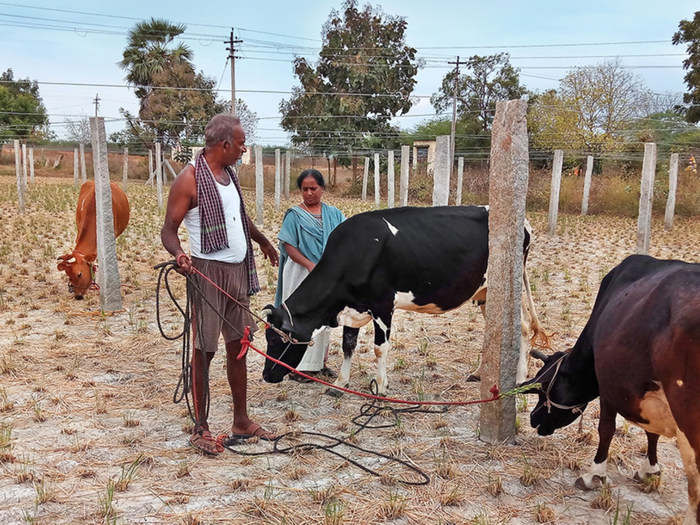
Cows grazing harvested paddy fields in an integrated cropping-livestock system
The International Atomic Energy Agency (IAEA) along with the Food and Agriculture Organisation of the United Nations (FAO) is helping farmers in India use sustainable methods of agriculture in order to improve productivity and reduce greenhouse gas emissions.
Food prices in India, and the world, are expected to rise regardless of climate change in the face of a growing population and increasing incomes and yields from two of India’s primary staples — rice and wheat — have been stagnating.
The ₹650 billion ($9.33 billion) project in collaboration with the Indian government is aimed at protecting India’s five biggest and most vulnerable ecological landscapes — the Chambal region in Madhya Pradesh, Dampa in Mizoram, Odisha’s Similipal, Jaisalmer and Barmer in Rajasthan and the national wildlife corridor passing through Uttarakhand.

Assam Governor P.B. Acharya participates in 'Clean India Campaign', a project partially financed by the World Bank, in Kokrajhar
The World Bank has also built a portfolio of strategic climate investments to in order to help India grow while keeping on a low carbon path.
Currently, the international financial institution has three ongoing water resource management projects in Andhra Pradesh, Tamil Nadu and Karnataka as well as a number of soil and water conservation projects, soil waste management projects, energy projects and forest projects in other parts of the country.

A kite fainted due to heat a bird lover feeds it with water to regai its body temperature tocome to normal in Mumbai
In September last year, India participated in the Global Action Summit in California, United States. It helped the country cement its credentials as a leader when it comes to climate change.
The Indian state of Maharashtra, and six others, agreed to adopt ‘Heat Action Plans’ that included installing ‘cool roofs’ and shifting the public transport system to electric buses.

A view of the 7.84 MW solar power plant installed in India's national capital, New Delhi, at the Indira Gandhi International Airport (IGIA)
India’s Solar Energy Initiative was well underway before the Paris Agreement in 2016 but the country’s plans to be the world’s greatest solar energy success has been struggling in the face of expensive solar equipment and increasing import duties.

Clouds of black smoke of coal dust near Anpara Thermal Power Station at Sonbhadra district in Uttar Pradesh
The Bureau of Energy Efficiency (BEE) and the Alliance for an Energy Efficient Economy (AEEE) brought out India’s first ‘State Energy Efficiency Preparedness Index’ in August 2018.
It categories the Indian states as ‘front runner’, ‘achiever’, ‘contender’ or ‘aspirant’. The south Indian state of Kerala came in first at the time of its inauguration with 77 points on the index.
Energy security is key for India since the two primary sources of power in the country are thermal and hydro power plants — both of which depend on water. Variability and fall in the level of river flows, as is a consequence of climate change, poses physical risk to the power plants as well as impact availability.

A view of Gowdagere viilage located 80 km from the city of Bengaluru, which has been chosen to be developed as `smart village' in the south Indian state of Karnataka
Select states in India — Orissa, Maharashtra, Himachal Pradesh and Bihar — came up with their own plans to counter climate change. Unfortunately, Maharashtra’s plan to counter global warming wasn’t up to the standards of environmentalists and meteorologists in India.
Orissa’s five-year plans to counter climate change have been going strong but the state boundary is still slowly disappearing out to sea.
Himachal Pradesh, on the other hand, was one of the first states to have its climate-smart agriculture (CSA) profile approved. And, Bihar collaborated with the Borlaug Institute for South Asia (BISA) to launch a project to revamp 100 villages in the state into ‘smart villages’.

A farmer arranging pump set to pump water to his dried agriculture land at Kozhikode, Kerala
Last year’s Economic Survey of India highlighted how climate change is heavily affecting farmers around the country, in terms of productivity as well as income. This doesn’t bode well in a nation where more than 60% of the agriculture — a sector that employs 50% of the Indian workforce — is rain-fed making India highly dependent on groundwater.
Even if climate change isn’t taken into account, 15% of India’s groundwater resources are over utilised.

Mumbai's once-thriving coastal eco-system has been robbed of mangroves and now stands exposed to erosion and threat of rising sea levels
Ghoramara Island, an island in eastern India, and Majul Island, belonging to the northeastern state of Assam, are slowing disappearing because of rising sea levels.
And, it’s not just islands that India has to worry about. The country’s film and financial capital, Mumbai, is home to the world’s largest population that’s exposed to coastal flooding. And, as is the case with Delhi, further rapid and unplanned urbanisation as more immigrants come into the city will only increase the risks of rising sea levels.
And, where one part of the country is sinking, the other is experiencing water stress and the demand for water rises. Urbanisation, the rapidly increasing population, the changing nature of economic development and energy demands are only some, albeit important, causes.
Tackling climate change is a complex problem is many facets that have to be balanced in a sustainable in order to field a favourable outcome.

Copyright © 2024. Times Internet Limited. All rights reserved.For reprint rights. Times Syndication Service.